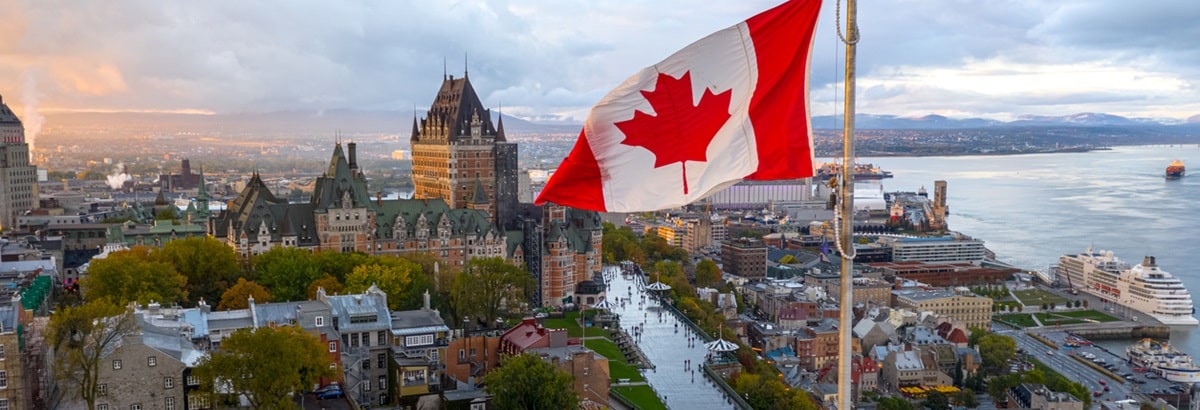Gonzalo Sanz Segovia | 18/09/2025
A Canadian emblematic city, Quebec is considered the cradle of Francophone civilization in America. Surrounded by mountains, rivers, and lakes, it stands out for its high quality of life and ranks among the safest towns in the country. However, it also faces natural risks that require an effective prevention and response system to protect its inhabitants.
Although Quebec is known for its tranquility, it is part of an extensive and diverse country with threats of different kinds and potential impact. According to the Spanish Ministry of Foreign Affairs, Canada is a safe destination, although not free from extreme natural events that should be taken into account, especially related to climate change. According to a report led by Environment and Climate Change Canada, annual seasonal temperatures in the country have increased at a rate significantly higher than the global average, with a rise of 1.7 °C between 1948 and 2016, especially pronounced in northern Canada (2.3 °C) and during winter, compared to the south and summer. More than half of this warming is due to greenhouse gas emissions caused by humans.
Climate projections indicate that, in a low-emissions scenario, the average annual temperature could increase by another 1.8 °C by mid-century; whereas in a high-emissions scenario, it could exceed 6 °C by the end of the century. The consequences are palpable to this day: the region usually faces severe wildfires every summer, and flooding is common in spring.
The challenge of a large city
The exceptional location of Quebec, situated at the confluence of rivers and surrounded by vast forested and mountainous areas, turns its privilege into a vulnerability. The geographic features that shape its identity place it in one of the areas of the country most prone to natural disasters: wildfires, river floods, and extreme frosts. This context is compounded by the challenges typical of any large city (it is one of the most populated in Canada), such as law and order management, public care, or health emergency preparedness. All these factors require a coordinated response from the protection agencies to anticipate and act efficiently in the face of any eventuality.
One of the initiatives undertaken by local authorities is the OASIS program, which aims to provide financial support to municipal organizations and Indigenous communities to plan and carry out ecological projects that reduce the impact of climate change. The program promotes green infrastructure solutions—such as green roofs, gardens, and retention basins—to help mitigate the effects of floods and heatwaves.
Forest fires: a growing challenge
Due to high temperatures, Quebec is increasingly exposed to forest fires, which have increased in frequency and intensity in recent years. In 2023, the province experienced one of the most extreme seasons in its history, with a drought that fueled the spread of wildfires. The fire impacted the forest ecosystem, but also affected local communities—triggering a public health crisis due to poor air quality—and the economy. According to a subsequent study by the Canadian Journal of Forest Research, the fires destroyed more than 4.5 million hectares, severely affecting key sectors such as agriculture and the critical infrastructure of the province.
To address this challenging context, the Government of Quebec and federal authorities launched the Fighting and Managing Wildfires in a Changing Climate (FMWCC) program in 2022. Through this initiative, more than $346 million have been allocated to strengthen wildfire management capacity by training new firefighters and acquiring specialized equipment, with the goal of enhancing the region’s resilience. Both the city and the province have detection systems (both satellite and land), as well as monitor towers in the most vulnerable areas and thermal imaging cameras.
Prevention is also a key aspect of their wildfire strategy, as 80% of reported fires are caused by human activity. To combat the statistics, Quebec has the Société de Protection des Forêts Contre le Feu (SOPFEU), which is responsible for managing forest fires in the province. One of their main tasks is to provide real-time information about the status of active fires, as well as to advise the public on risks and best practices to prevent them.
Continuous training and the reinforcement of resources are key for this institution. Since April 1, 2025, Quebec has the Civil Security Emergency Response Reserve (RIUSC), a specialized team of 200 professionals ready to deploy in the event of any natural disaster. This initiative, a pioneer in the Americas, aims to complement municipal efforts, especially in situations where local resources are insufficient. Among its obligations is infrastructure protection, establishment of shelters, and logistical support during the crisis. Its members, coming from organizations such as SOPGEU itself and the Red Cross, have received theoretical and practical training supported by the Government of Quebec.
Prevention and response to floods
In its recent history, Quebec has experienced major flooding events, such as those in 2017 and 2019, when thousands of homes were affected and economic damages were substantial. Its river environment, spring thaw, and frequent heavy rains mean that these events are not isolated occurrences. In fact, in July the city experienced the onslaught of a severe storm—up to 155 millimeters of water per hour were recorded—which flooded the roads and caused power outages. Despite the impact, the response of the emergency services was quick, and there were no human losses.
To address this constant risk, the government of Quebec has adopted a new regulatory framework for the flooded areas of the region, whose maps will be expanded by 30% and will come into effect in March 2026. Homeowners in high-risk areas will not be able to build new homes or rebuild destroyed properties. Additionally, the category of “protected area with residual risk” will be included, covering zones with protective infrastructure such as dikes and walls. The adaptation strategy for this scenario includes relocating vulnerable communities and strengthening strategic structures.
In addition to this initiative, Quebec has established the Intersectoral Flood Network (RIISQ), a platform for exchange and integration that brings together all governmental, socioeconomic, and research stakeholders from the social, scientific, technological, medical, economic, and political fields to enhance Quebec’s capacity to prepare for and protect against floods. In 2024, the renewal of its $4 million funding was announced for a period of four years (2024–2028), under the leadership of Philippe Gachon, a professor in the Department of Geography at the University of Quebec in Montreal (UQAM). With its initiatives, Quebec has become a global leader in flood management by synchronizing precise mapping, regulation, and zoning with a public-private collaboration model for comprehensive disaster prevention and response.





